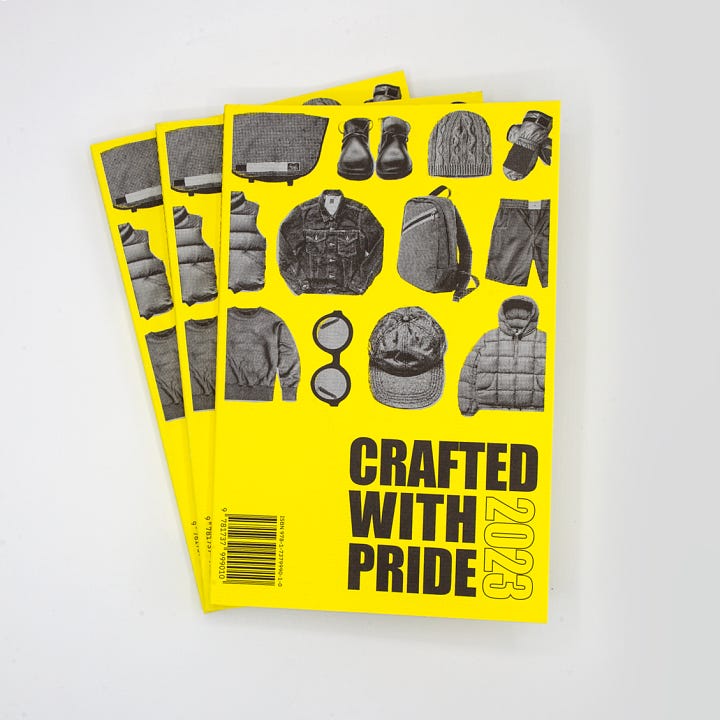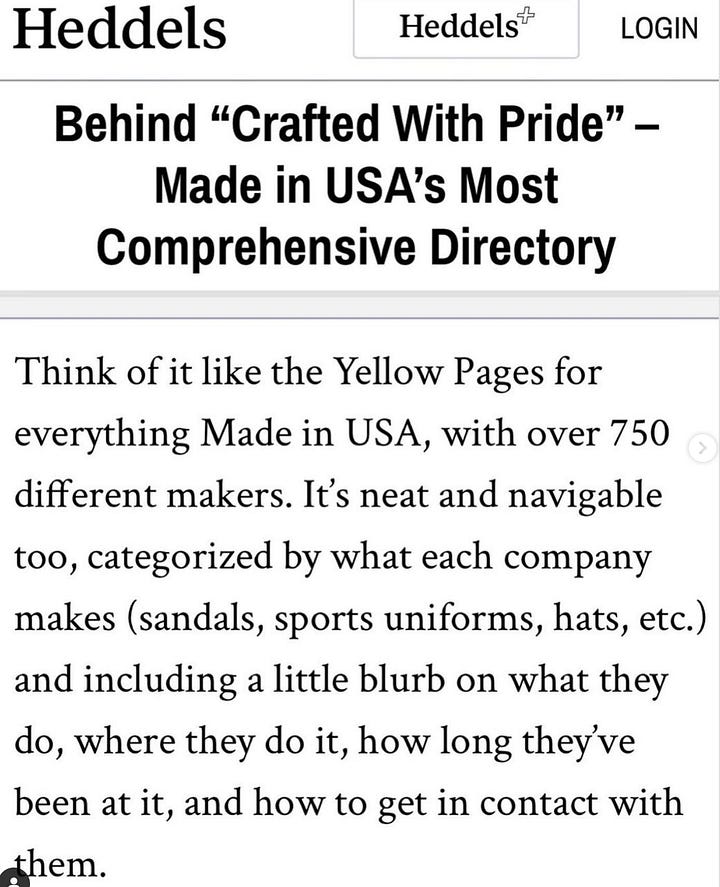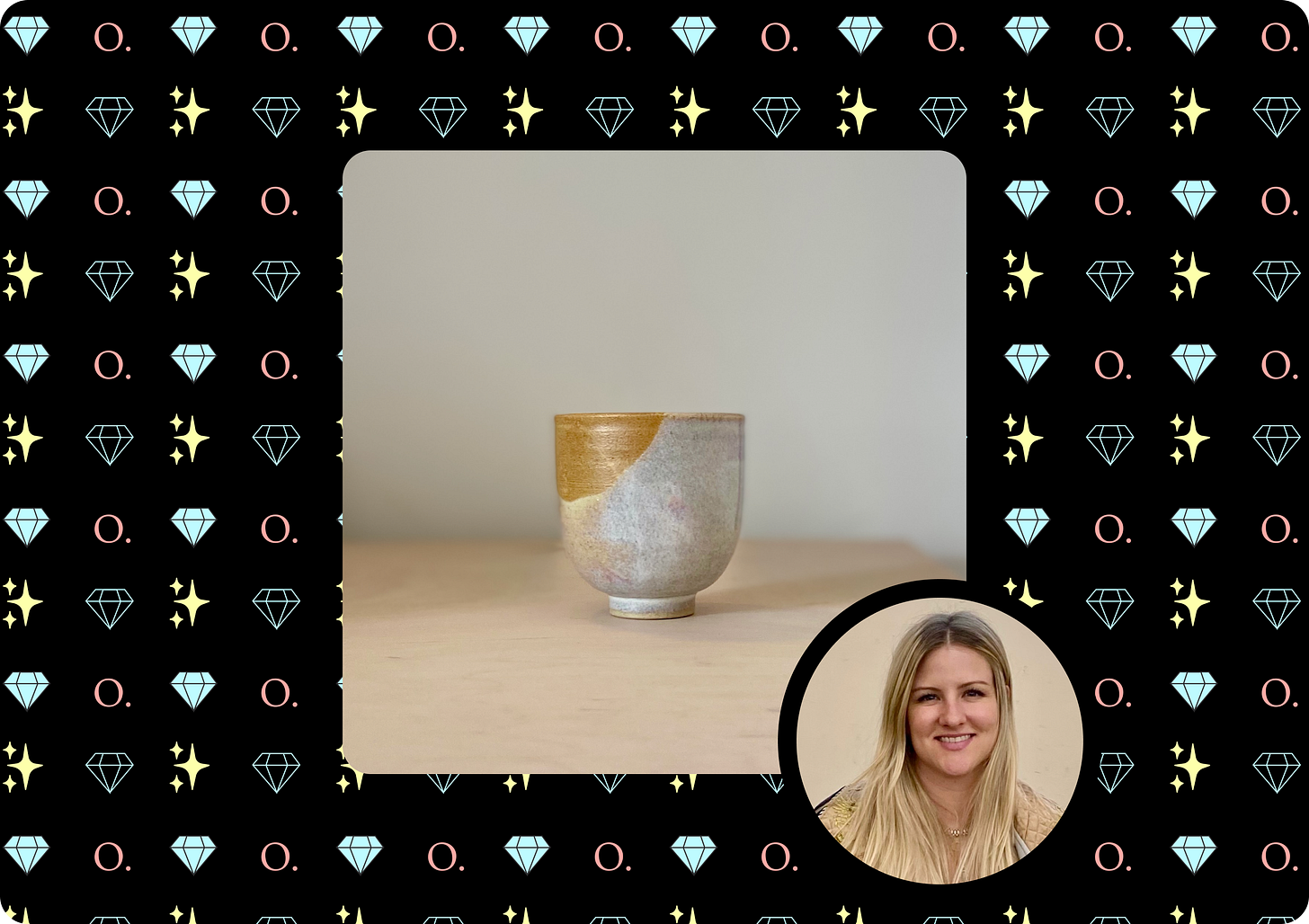#071 ✰ (Re)connecting with objects
SoaO: Rendl's Japanese teacups • Levi's 150th birthday • USA makers directory • wise words
Hey there 👋 Back to our weekly post. I’m Mathilde. We are Objet. We explore the intersection of consumerism, myth, satisfaction, desire, taste, joy, meaning and pride. Not specifically in that order. To brag at your next dinner, Objet is the french word for 'object' and should be pronounced 'OB-JEH'.
If you’re new here, welcome 👋
In today’s Objet journal:
Our mission 👉 Wait, what are they onto again?
Soul of an Objet 👉 Rendl’s Japanese teacups
What’s up on the app 👉 Tailored product recommendations with 🤖 objet_ai
Cool reads, ‘cause it’s always cool to read cool stuff
Our mission
The relationship we, humans, have with shopping - and our objects as a whole - is broken: we want to bring back joy and pride. Objet is where style shops mindfully.
Soul of an Objet | Rendl Clark
Sublime possessions have soul and meaning. Meet Rendl’s Japanese Teacups, the first pieces of ceramics she made when she moved to London and joined her new studio.
Rendl grew up in a ranch in California before falling in love with the mountains of Colorado, and more recently moving to London. Throughout these years she’s nurtured her passion for pottery and creating objects.
Rendl’s Objet profile | her ceramic venture
Hi Rendl! So what's the backstory of this object?
Four years ago I left my life in Colorado and moved to London. I had to condense 14 years of belongings into two suitcases. Needless to say, most of my items that made the cut were clothing and the majority of my personal objects have been living in storage.
In my early 20s, I began taking ceramic courses in the evenings. Fast-forward eight years and I had a seat on the board of the nonprofit that ran the pottery studio and was spending 8+ hours per week making. Before and during the UK move I had to put making ceramics on hold. After a few months of being in London, I was finally offered a place at a community studio. Sinking my hands into the earth and molding it into a creation out of my imagination is like coming home. It’s safe, nurturing, and familiar. These Japanese-style teacups were some of the first pieces I made in London. They are a combination of a style of throwing I learned in Colorado with clay and glazes unique to the UK. After a few months of making in the Hoxton community studio, I left my job in tech and subsequently started Mette Ceramics and began making in a professional studio here in East London.
Like any craft, it takes years to hone in on your skills, and these cups, although quite simple, are delicate and fun to hold. Since starting my company I’ve made over a thousand pieces and these still hold a special place in my heart and live in my kitchen cupboard. When I look at these cups they remind me of how subconscious I felt when I first moved to London, and again when I started my business. I remember calling a good friend and mentor of mine back in Boulder and sharing the news of wanting to go full-time with pottery. She said, many encouraging things but the phrase that stuck with me is, “The world needs more beautiful things.” Every time my business gets challenging or I have doubts about a piece I remember those words. There is nothing in the world like holding a piece of art that has been made to do something so simple as to hold a cup of tea. It makes me smile. To me, these cups hold so much meaning since they represent a challenging time in my life and how mud from this humble earth got me through it.
What object’s been your best investment?
My Topo Designs backpack. I love that thing. It’s been with me all over the world. Every single plane ride I’ve taken for the past decade it’s been by my side. Works trips, the Maldives, ski trips, you name it. It works just as well today as it did the first day I bought it. I also love that it’s made by a Boulder-based company so I always bring a little piece of home with me wherever I go.
Is there any other type of things you truly like to dig into?
Growing up my mother collected early American antiques (think late 1700s). Her antiques are definitely not my style but, at a young age, I learned how to spot unique finds. When I purchased my first home in Colorado I started buying items second-hand as I found that vintage furniture was made with more craftsmanship than new furniture. I also love a good hunt! When I moved to London I had to furnish our flat quickly and cheaply. I lived near a local auction house, they held weekly auctions, and the treasures you can find for next to nothing are astounding. I try to always purchase quality pieces second-hand as the amount of waste I see here in the city is overwhelming. I’ve been able to share this little hobby of mine with friends and I love seeing people repurpose and reuse items that already exist vs. purchasing them new.
What's the next purchase you're currently contemplating?
I’ve been looking for a gold signet ring for ages and just recently stumbled into an antique one last week. Feels so good to find something old and new at the same time. Now that I’ve found that I’m taking a break from “the hunt” and focusing on some upcoming travel.
Would you have any 'tip' to take care of an object and/or material?
I have quite a few heirloom jewelry pieces from my Grandmother. I love wearing them as it feels like I'm bringing a tiny piece of her with me each day. To keep the pieces clean and shiny I created a simple easy way to clean jewelry. All you need is a dash of baking soda and dish soap together in a jar. Soak your jewelry for a few minutes and then clean it with an old toothbrush. Voila!
Thank you!
👀 Did you know? Once you onboard on the app, you can respond to and engage with cool people like Rendl in one click.
What’s up in the app
The first version of 🤖 objet_ai, your tailored product recommendation assistant powered by AI is one week old. Give it a try before you place your next purchase!
Cool reads.
🎂👖 May 1873 - May 2023: 150 years of blue jeans
This month marks the 150th anniversary of the Levi’s 501 jean. One hundred and fifty years (!) Former Global Brand President
(who had to step down in 2022 “because of [her] advocacy of reopening public schools, a stance the company couldn’t stomach”) gives a pretty cool history recap in her latest piece when great American brands sabotage their own success.That Levi Strauss and Company is synonymous with the most iconic and best-selling garment of all time — the 501 — is a fact. (…) The company was started by an enterprising Bavarian-born dry goods merchant during the gold rush in California in 1853. (…)
One of Strauss’ early customers was a tailor named Jacob Davis. Strauss, the commercial brains of the operation, partnered with Davis to create denim coveralls, what we know now as blue jeans. Upon listening to customers who told him their pants weren’t holding up to the strenuous work they did in mines and elsewhere, Davis came up with the idea to use tough tent-making fabric, fastened at the seams with metal rivets for durability. And this riveted coverall looked a whole lot like today’s jeans.
Strauss and Davis supposedly went in on a patent together in 1873. The patent was for “Improvement in Fastening Pocket-Openings.” And voila, the blue jean had arrived, according to fashion lore. It would soon change the way we all dress, reaching far beyond laborers to define casual clothing and a rebellious spirit for generations. Worn by Marlon Brando and Elvis, Debbie Harry and Beyonce, Kurt Cobain and Snoop Dogg. 1950s rebels, 1960s hippies, 1970s punk rockers, and 1990s grunge bands. Spirited rebellion is in Levi’s genes.
Levi’s key moments:
In 1934, Levi Strauss and Company introduced Lady Levi’s, the first jeans made for women.
In 1936, Levi’s introduced the red tab on the right back pocket. Branding the jeans in this way signaled to consumers “This is a pair of Levi’s.” Implicit: accept no substitute.
During World War II, Levi’s racially integrated their own factories in California, despite the fact that some employees protested, and some even quit.
In 1991, Levi’s introduced health and safety standards in their contracted production factories, where nearly all apparel workers were, and still are, women.
In 1992, Levi’s was the first Fortune 500 company to offer same-sex partner benefits, long before marriage equality was a leading discussion in what we now call “the culture wars.”
In 2015, Levi’s reimagined their entire women’s product line. This effort drove outsized growth for the company for the next five years, making Levi’s the largest jeans brand for women in the world.
***
📍🇺🇸 Local brands, state by state
Oh dang!! This directory is right up our alley 💥
Crafted With Pride is the brainchild of two gear fanatics dedicated to evangelizing underrepresented local brands. The aim was to create a comprehensive and totally independent (no paid advertisements or endorsements) buyer’s guide for like-minded individuals who wish to consume more thoughtfully while deepening their knowledge of brands and their product offerings.


***
🛍 Dealing with our insecurity
Getting lost in internet craving loops: we’re all shopping addicts now. The conclusion sends shivers down your spine yet says it all about (among) the most spread-out curse of our time: overconsumption.
We shop recklessly when we feel it’s all we have.
***
🤝 Live the present
What if we love and use the objects we own? Instead of living in the fear of not being able to resell them one day. An interesting perspective on resale from
Resale is shorthand for not knowing the true joy of ownership.
***
❤️🩹 Repair is the new cool
“The linear “take-make-waste” model is no longer working,” (…) “The design industry needs to embrace the circular economy, and fast.” Says author, podcaster, and keynote speaker Katie Treggiden



If you got all the way here and have been seeking a better way to experience shopping & enjoy your possessions, alongside enthusiastic, not-so-serious souls, try Objet:
… share Objet journal with a soulmate 👯
… subscribe to Objet journal to receive new posts 🛼
Til next time,
Mathilde 🪄






